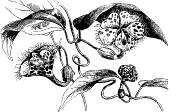 Huernia schneiderana Huernia schneideranaAbout two-thousand species of Asclepiadaceae are split into some 300 genera of which, about half are succulent. Numbers of species gathered from available literature are provided as a guide, but change frequently from botanical revisions or discovery of new species.
The Asclepiadaceae were orginally included in the Apocynaceae by Jussieu (1789) but controversially split into a family of their own by Robert Brown in 1810. Following recent work on DNA analysis and other morphological studies, they have been merged back into a sub-group of the Apocynaceae. Most people seem to have accepted this revision, although only time will tell if it becomes a permanent change.
|
- Folotsia - 5 species of lianes with vestigal scale leaves - Madagascar
- (Gomphocarpus) = succulent Asclepias
- Gonolobus - 100 species (not all succulent) - Americas
- Karimbolea
- Kinepetalum
- (Prosopostelma) = Folotsia
Stapelia Group
The large Stapelia group is subdivided :-
- Caralluma Subgroup
- Caralluma - 87 species - southern Mediteranean and Northern Africa to India
- Desmidorchis
- (Diplocyatha) = Orbea
- Duvalia - 21 species
- Duvaliandra - 1 species
- Frerea - 1 species
- Huernia - 64 species - southern Africa to Arabia
- Huerniopsis - 2 species
- Luckhoffia
- Ophionella - 1 species
- Orbea - 56 species
- Orbeanthus - 2 species
- Orbeopsis - 10 species Image: Orbeopsis caudata
- Pachycymbium - 3 species
- Pectinaria - 3 species
- Piaranthus - 16 species - mat formers - South Africa, Namibia
- Quaqua - 13 species
- Stapelia - 43 species - Southern Africa
- Stapelianthus - 8 species
- Stapeliopsis - 6 species - southern Africa, Namibia Image: Stapeliopsis urniflora
- (Stultitia) = Orbea
- Tavaresia - 2 species Image: Tavaresia barkleyii
- Tridentea - 16 species
- Tromotriche - 10 species
- Echidnopsis Subgroup
- (Drakebrockmania) = Whitesloania
- Echidnopsis - 20 species
- Edithcolea - 1 variable species
- Notechidnopsis - 2 species
- Pseudopectinaria - 1 species
- Rhytidocaulon - 8 species
- Trichocaulon Subgroup
- Hoodia - 18 species - spiny stems - South Africa Cape Province, Namibia
- Lavrania - (smooth Trichocaulon) - 2 species
- (Lithocaulon) = Pseudolithos
- Pseudolithos - 4 species
- Larryleachia - 5 species - smooth stems - South Africa Cape Province, Namibia
- Whitesloanea - 1 species
Ceropegia Group 
- Ceropegia - around 160 species - Africa to Australasia
- Brachystelma - over 100 species - Africa to Australasia
- Cynanchum - 55 species - tropical and temperate
- Dischidia - 80 species - south-east Asia to Australasia - specialised ant hosts
- Fockea - 11 caudiciform species - southern, eastern and tropical Africa
- Hoya - around 300 species of epiphytic climbers - south-east asia to Pacific
- Microloma - 10 species of slender climbers or shrubs - South Africa, Namibia
- Pachycarpus
- Raphionacme
- (Riocreuxia) = Cereopegia
- Sarcostemma - reduced to a synonym of Cynanchum
- Philibertia (Sarcostemma) - herbs and twining vines, leaves in pairs
- (Siphonostelma) = Brachystelma
- Stomatostemma
Mainly non-succulent Asclepiad Genera
There is also a range of non-succulent asclepiads that are not eligible to be shown in succulent asclepiad or other succulent classes, but some of which may be of interest to Asclepiad enthusiasts. Species with large, unusual or brightly coloured flowers or prominent seed pods may be of horticultural merit.
- Asclepias - milkweeds from Africa and the Americas, some hardy and suitable for garden use
- Ditassa - 75 species - South America
- Gonolobus - 100 species (some succulent) - Americas
- Ischnolepis - monotypic genus (Ischnolepis graminifolia), a tuberous-rooted shrub with linear leaves in whorls, from Madagascar
- Marsdenia - 100 species of shrubs with caustic latex - E. Mediterranean to Malaysia, Madagascar
- Matelea - 130 species - tropical South America
- Mondia - 2 species - tropical Africa
- Oxypetalum - 80 to 100 species - tropical America
- Pentopetia - lianas (woody vines) with leaves in pairs
- Periploca - lianas (woody vines) with leaves in pairs - old world
- Secamone - 100 species of lianas (woody vines) with leaves in pairs- tropical old world
- Stephanotis - 15 species of woody climbers - S. Asia, Malaysia, Peru
- Tylophora - 50 species - tropical old world - includes Vincetoxicum
|










